Composting turns kitchen scraps and yard waste into rich soil for your garden.1 This guide helps you start your first compost bin. We’ll cover picking the best spot and what you need. You’ll learn how to care for your compost for the best dirt for your plants. By composting, you reduce trash by 30%, cut your carbon use, and improve your soil. This is for anyone, from tiny spaces to large yards, wanting to compost at home.
Key Takeaways
- Composting can divert up to 30% of household waste from landfills1
- Compost introduces beneficial organisms to the soil, aiding aeration, decomposition, and disease prevention1
- Maintain a balanced ratio of one-third green and two-thirds brown materials in your compost pile1
- Choose a compost bin or setup that suits your living environment and composting needs1
- Regularly turn and monitor the moisture levels in your compost pile for optimal results2
Introduction to Composting
Composting is a natural way to turn kitchen and garden waste into rich soil. This soil booster is called compost. It keeps about 30% of household waste away from dumps1. Composting makes soil healthier and cuts down the bad effects of throwing away food and plants.
Benefits of Composting
Composting is good for the earth and the economy. It changes food leftovers and yard clippings into something that makes soil better. This helps reduce the huge amount of waste that sits in landfills, more than 28 percent in the U.S.3. The final compost makes soil perfect for gardens, keeps water in the ground, and helps plants grow strong.
Types of Composting
There are a couple of ways to compost.4 Hot composting is done in special bins that keep the pile warm. This means you can add things like meat and cooked foods. Cold composting uses simple bins or even just a pile. It’s best for throwing in garden scraps and some food scraps.4 If you have a small space or want to compost indoors, there’s also worm composting and Bokashi. These are great for apartments or houses with not much outdoor room.
Gathering Compost Materials
The secret to good compost is getting the right mix of green and brown stuff. Green stuff has nitrogen, which helps good bacteria grow. Brown stuff has carbon, giving the compost energy.5
Brown (Carbon-Rich) Materials:
- Dry leaves
- Shredded paper and cardboard
- Straw or hay
- Sawdust or wood chips
- Pine needles
- Corn stalks or cobs
- Shredded newspaper (avoid glossy paper and colored inks)
Not everything should go in the compost. Some things can cause problems:
- Meat, bones, and fish scraps (they can attract pests and rodents)
- Pet waste (may contain harmful pathogens)
- Diseased plants or weeds with seeds (can spread diseases or unwanted plants)
- Cooking oils and greases (can create odors and attract pests)
- Chemically treated wood or sawdust (may contain toxins)
- Black walnut leaves (contain a compound that can inhibit plant growth)
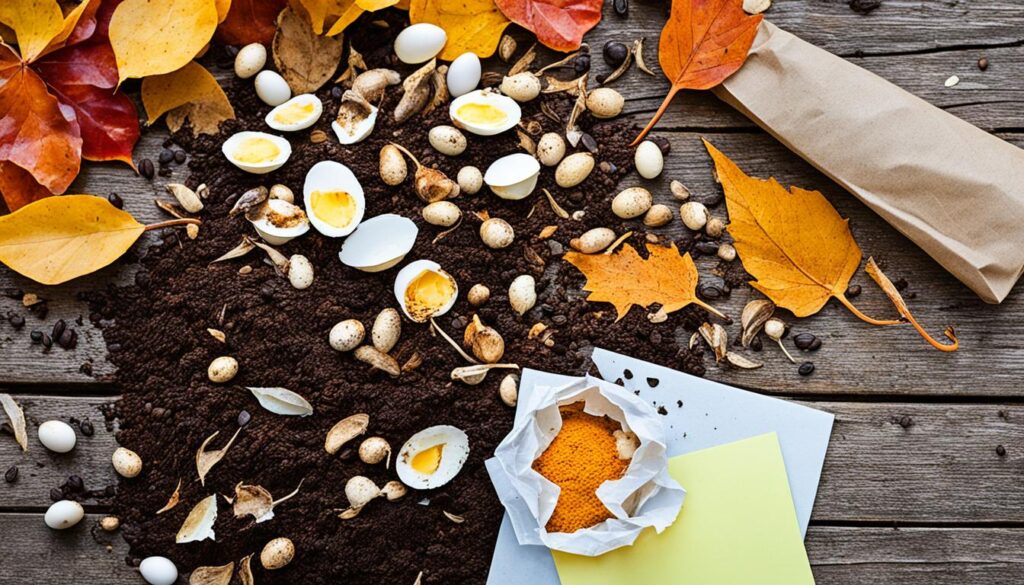
Choosing the Right Compost Bin
When it comes to composting, you’ve got choices. You can go for open piles, enclosed bins, or compost tumblers. Each has its own benefits.
Enclosed Compost Bin
An enclosed compost bin, whether you buy it or make it yourself, keeps your compost controlled. It’s a neat way to compost.6These bins come in different materials, like wood, plastic, or wire mesh. They have a lid for holding in moisture and warmth. Enclosed bins stop pests and fit well in small yards.
Compost Tumbler
Compost tumblers are bins you can spin to mix your compost. This mixing adds air, speeding up the composting process.With compost tumblers, turning your compost is a breeze. This motion is key to making good compost fast.They’re also off the ground, which means less bending over and turning from top to bottom.
Setting Up Your Compost Bin
Location matters when setting up your compost. Pick a place that’s flat and has good drainage. This keeps the compost from getting too wet.6 Also, choose an area that gets some sun but not too much. This prevents it from drying up or being too wet. Make sure it’s away from places animals might visit.
Building the Base Layer
First, create a base layer using items like twigs or straw.6 This layer improves airflow and lets excess water drain. Place this layer on the ground for bins, or on soil for open piles.
Layering Green and Brown Materials
Next, add alternating layers of green and brown materials.6 Green materials are rich in nitrogen, like fruit scraps. Brown materials, such as leaves, provide carbon. Add a little water to each layer and gently press down.
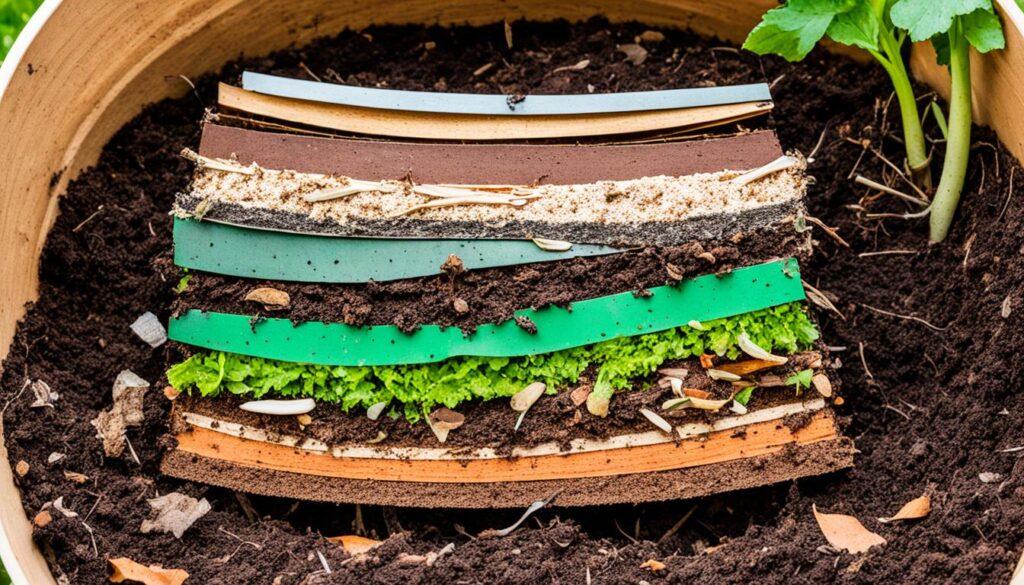
| Green (Nitrogen-Rich) Materials | Brown (Carbon-Rich) Materials |
|---|---|
|
|
Keep the balance of green and brown right for good compost.6 Check the moisture and mix it up to help it break down evenly. This will make sure your compost does its job well.
Maintaining Your Compost Bin
Keeping your compost bin at the right moisture level is key for it to work well. Ideally, your compost should feel as moist as a wrung-out sponge. There should be water visible but not pooling. To fix dry compost, add water. Too wet? Add more dry, brown materials to soak up the extra water.7
Mixing your compost regularly is crucial for it to break down well and stay fluffy. You can use a pitchfork or shovel for this. Move the drier parts from the edges to the middle. Doing this every week or two adds oxygen and makes the organic stuff break down faster.
When you add kitchen scraps, yard cuttings, or any other stuff, keep a balance. Green materials like food scraps need to match with brown materials like leaves. Always mix new stuff with the old compost. Don’t just dump it on top. This mixing keeps the compost even and speeds up the process.
Troubleshooting Common Composting Issues
Even with the best intentions, composting can come with its own set of challenges. Let’s tackle some common issues together:
During hot summer months, your compost can dry out. This can slow down the decomposition.8 To keep it moist, water the pile often. Also, think about using a tarp to keep water from evaporating too quickly.
A pile that’s too wet smells bad and lacks oxygen for decomposition.8 Add more dry, brown materials like straw, leaves, or hay if this happens. They’ll help soak up the extra moisture.
If your compost smells bad, it might mean you have too much nitrogen. This comes from things like fruit peels or grass.8 Add more brown materials, such as newspapers, cardboard, or woody items. They will help balance the pile.
Is your compost not breaking down fast enough? Large items, like eggshells or corncobs, could be the problem.8 Try cutting them up smaller. This speeds up the process. Also, try burying kitchen scraps in the garden. It can help them decompose quicker than in the compost bin.
| Composting Issue | Possible Cause | Troubleshooting Tip |
|---|---|---|
| Dry compost | Summer heat and lack of moisture | Water the pile regularly and consider covering it with a tarp. |
| Wet, odorous compost | Too much moisture and lack of oxygen | Mix in more carbon-rich brown materials like straw, leaves, or hay. |
| Unbalanced nitrogen-to-carbon ratio | Too much nitrogen (green materials) | Add more brown materials like shredded newspaper, cardboard, or woody stems. |
| Coarse finished compost | Slow decomposition of materials like eggshells and corncobs | Shred or chop materials before adding them to the pile; bury kitchen scraps directly in the garden. |
Handling these common compost problems helps keep your compost healthy and smell-free. It also makes sure you get great compost for your garden.8
How to Start a Compost Bin
Starting a compost bin is easy. First, pick a good spot, as we talked about. Get rid of grass and weeds. Make sure the ground is flat for water to drain well.6
Choosing the Right Bin Type
Think about what compost bin suits you. A simple pile works. But, bins and tumblers keep things neat. Your choice should match how much compost you’ll make, your space, and your effort to keep it up.
Balancing Green and Brown Materials
When you start, stack green and brown stuff right. Use about one part green to three parts brown. This mix helps feed the compost and keeps air flowing.6
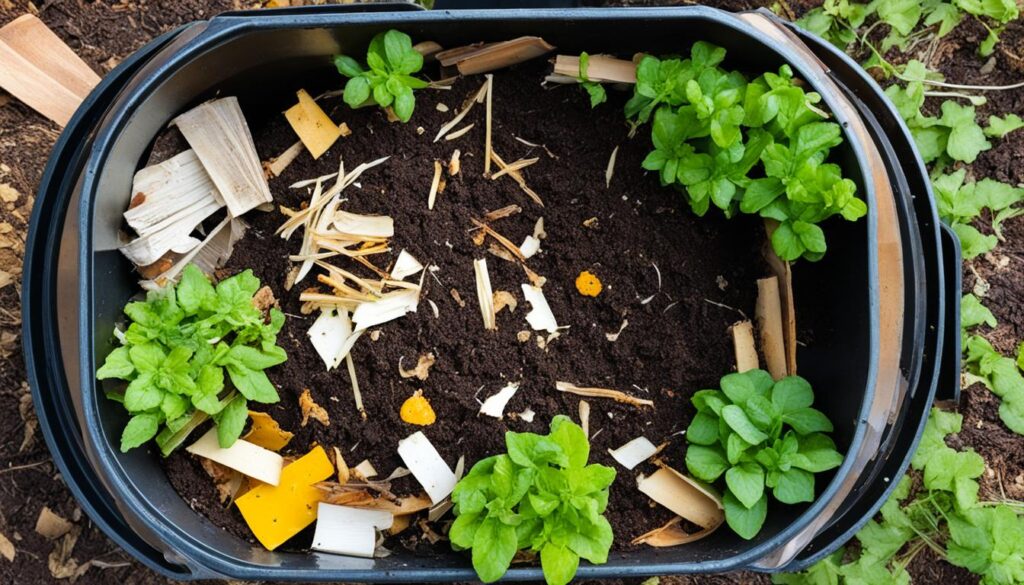
| Green (Nitrogen-Rich) Materials | Brown (Carbon-Rich) Materials |
|---|---|
| Food scraps (fruits, vegetables, coffee grounds) | Dry leaves, shredded paper, and cardboard |
| Grass clippings | Straw, hay, or sawdust |
| Manure from plant-eating animals | Shredded twigs and branches |
To succeed in composting, keep the greens and browns balanced.6 If you follow these tips, you’ll start your compost bin well. You’ll turn kitchen and yard scraps into soil booster for your plants.
Using Finished Compost
After your compost has fully turned dark and smells earthy, it’s good for the garden. It improves soil by making it hold water better and have more nutrients.9 You will know it’s ready when it feels crumbly, looks rich, and is dark.
Use the compost around plants or in garden beds. This helps the soil and the plants grow better.
Amending Garden Soil
Put a top layer of compost on your lawn to make it better.9 It’s great for mulch, top dressing beds, and feeding plants. It makes the soil hold water and nutrients, making your lawn greener.
Top Dressing for Lawns
You can also mix compost into soil for potted plants.9 It’s full of nutrients that plants need. Add perlite or vermiculite to make it good for drainage, both inside and outside.
Potting Mix for Containers
9 Compost brings worms and other good bugs. It’s perfect for making your own plant soil, compost tea, or feeding plants in spring and fall.
Advanced Composting Techniques
Want to make compost faster? Hot composting could be what you need. It keeps the pile at 130-150°F and can give you compost in 4-6 weeks.1 It’s a bit more work, though. You have to turn it a lot and check the moisture.
Hot Composting
Hot composting speeds up the process by using high temperatures.1 It needs careful handling of water, air, and the materials inside. With the right touch, your compost is ready fast.
The result is a nutrient-packed compost you can use right away. This method demands more time, but the benefits for your garden are huge.
Vermicomposting (Worm Composting)
Vermicomposting uses special worms to turn scraps into compost.1 It’s perfect for inside, and the end product is great for plants and gardens.
Worms work wonders in vermicomposting. They transform your waste into fantastic compost with little work on your part. It’s a smart choice for indoor or small space composting.

Composting with Limited Space
If outdoor space is tight, you can still compost at home. Use an indoor composting bin. These units fit on your counter and are perfect for small amounts of kitchen waste. They stop organic waste from ending up in landfills, even in tight living spaces like apartments. Some good choices for indoor composting are worm bins, bokashi bins, and small, enclosed composters.10
Indoor Composting Bins
Worm composting, known as vermicomposting, is great for small areas. A worm compost container can be as small as a shoe box with holes. This method creates rich soil and compost tea.10 You can also use electronic bins like the Food Cycler or Zera Food Recycler. They turn food waste into soil nutrients quickly.11
Community Composting Programs
Out of space or time to compost at home? Many communities have composting programs. Residents can drop off food scraps and yard waste at set locations. Here, they turn it into compost.10 Check with your local officials to find out if your area has such a program.11
Services like WasteWell pick-up compost, cutting down on household garbage.11 The ShareWaste app connects those with compost space to those with food scraps. It’s a worldwide composting network.11
No matter where you live, you can find a way to compost indoors or through community programs. Doing so helps the planet by lowering trash and creating more earth-friendly habits.1011
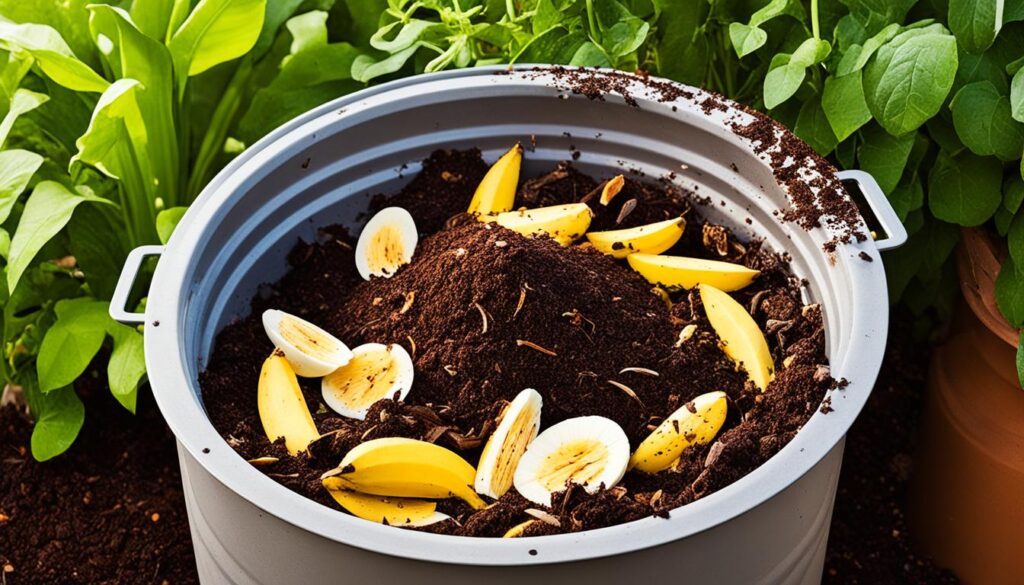
Composting and Sustainability
Composting is essential for sustainable living. It’s part of a circular economy. It helps by not throwing organic waste into landfills. So, there’s less methane gas harming our planet.3 The compost is great for soil. It helps plants grow better without harmful chemicals.
Reducing Waste
Composting is about making a full circle with our organic waste. Instead of calling it trash, we turn food scraps and yard waste into something valuable.3 This way, we feed plants with what they give back to us. It’s a big deal for sustainable and healthy living.
Closing the Loop
Composting keeps organic waste out of landfills. This means less methane hurting our environment. Plus, the compost enriches soil, helping plants grow strong.3 It’s a full circle of dealing with waste in a positive way for the planet.
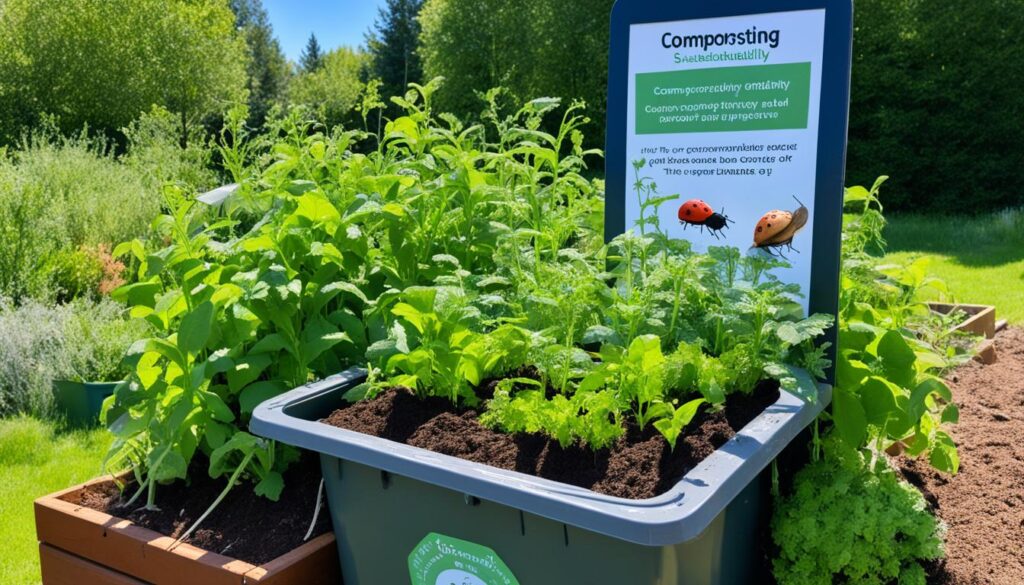
Conclusion
Composting is an easy way to turn food scraps and yard waste into soil for your garden. It reduces the waste in landfills, helping the planet.12
Composting helps fight global warming by cutting down methane. It also makes soil better without needing chemical fertilizers.12 Follow our guide to make a great compost, no matter where you live.
You can compost with a big pile outside, a bin, or even indoors. It’s important to add the right mix of green and brown waste, check the moisture, and stir it often.12 With some care, you’ll have rich soil for any plants.
Making your own compost helps the earth and your garden. It cuts down trash and keeps important nutrients cycling in the soil.1213 Making compost is a small, good thing you can do for the planet and your plants.
FAQ
What are the benefits of composting?
Composting is great for the planet. It stops about 30% of our trash from filling landfills. It also cuts down on the gases that hurt our atmosphere. Plus, you get amazing soil for your plants.
What are the two main types of composting?
There are hot composting and cold composting. Hot composting is faster and needs more work. Cold composting is easier but takes longer.
What are the key ingredients for successful composting?
For good compost, you need both green and brown stuff. Green things help grow tiny organisms. Brown things give them the energy they need.
What materials should be avoided in a compost pile?
Stay away from meat, bones, fish, and pet waste. Also, avoid sick plants, weedy seeds, oils, treated wood, and black walnut leaves.
What are the different types of compost bins or setups?
You can use open piles, enclosed bins, or tumblers. Each type has its own benefits. Open piles are the simplest, while bins and tumblers keep things neater.
What is the importance of the compost bin location?
Where you put your compost bin is key. It should be on flat ground with good water drainage. Avoid spots that are too wet.
How do you start a compost bin or pile?
First, lay down a thick base with twigs or straw. Then, pile on green and brown stuff in turns. Keep layering until you’re a few feet high.
How do you maintain the right moisture level in your compost?
Your pile should be damp, like a wrung-out sponge. It needs to be moist throughout but not soggy. Adjust the water if it’s too dry or too wet.
How often should you turn or mix the compost?
Turning your compost helps it decompose faster. Try to mix it every 1-2 weeks. This keeps air flowing and everything breaking down evenly.
What are some common composting challenges and how can they be addressed?
Stinky smells, pests, and too much or too little water are common issues. You can fix these by adding different materials, turning your pile more, and checking the moisture.
Source Links
- https://learn.eartheasy.com/guides/composting/
- https://www.gardeningknowhow.com/composting/basics/starting-compost-pile.htm
- https://www.nrdc.org/stories/composting-101
- https://www.asustainablelife.co.uk/the-absolute-beginners-guide-to-composting/
- https://homesteadingfamily.com/how-to-make-compost-the-easy-way/
- https://www.botanicgardens.org/blog/start-backyard-compost-bin
- https://www.familyhandyman.com/article/what-i-wish-i-knew-before-starting-a-compost-bin/
- https://www.gardeners.com/how-to/compost-troubleshooting/5155.html
- https://learn.eartheasy.com/articles/how-to-use-finished-compost/
- https://ecogardener.com/blogs/news/composting-in-small-spaces
- https://www.mywastewell.com/ways-to-compost-in-an-apartment-or-small-space/
- https://usfblogs.usfca.edu/sustainability/2020/05/18/my-composting-journey/
- https://geo300summer.wordpress.com/2012/08/17/composting-conclusion/
